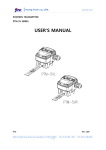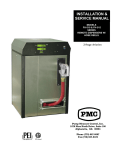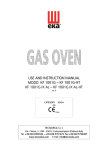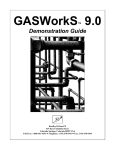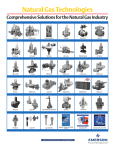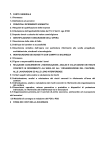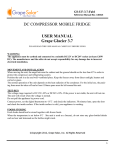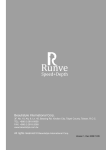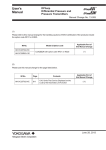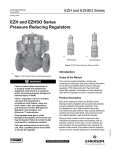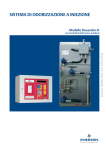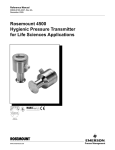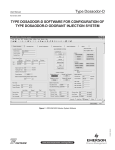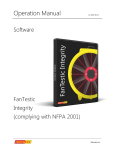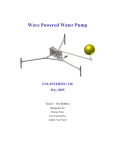Download Instruction Manual - Welcome to Emerson Process Management
Transcript
Type Dosaodor-D Instruction Manual Form 5790 May 2010 Type Dosaodor-D Odorant Injection System Controlled by Type ROC809 Remote Telemetry Unit for North America Installation Figure 1. Type ROC809 Remote Telemetry Unit Figure 3. Type Dosaodor-D Pneumatic Panel D103102X012 Figure 2. Standard Wick Insert O.M.T. www.emersonprocess.com/regulators Type Dosaodor-D Specifications Pneumatic Panel: Solenoid Valves: Material Stainless steel plate Body Material 304 Stainless steel Installation Wall mount Weight 55 to 100 pounds (25 to 45 kg) (based on configuration) Gasket Material Fluorocarbon (FKM) Valve Operation Electromagnetic Overpressure Relief Valve Maximum Working Pressure 870 psi (60,0 bar) Power Requirements 12 Vdc Stainless Steel with Following Rating Options: 200 psi (14,0 bar) 550 psi (38,0 bar) 870 psi (60,0 bar) Electrical Protection Explosion proof Class I, Division 1 and 2 - Groups B, C, D Class I, Zone 1 and 2 - Groups IIB + H2, IIA Mechanical Connections Odorant Inlet and Discharge 1/4-inch (6,4 mm) OD Tube fitting (double ferrule) Gas Inlet and Discharge 3/8-inch (9,5 mm) OD Tube fitting (single ferrule) Maximum Working Pressure Supply: 1450 psi (100 bar) Injection: 870 psi (60,0 bar) Odorant Flow Rate 0.13 to 3.70 gallons per hour (0,5 to 14,0 l/hr) (0.89 to 24.97 pounds/hr at 6.75 pounds/gal) Temperature Range 14° to 140°F (-10° to 60°C) Odorant Calibration Cylinder: Body Material 304 Stainless steel Maximum Working Pressure 870 psi (60,0 bar) Maximum Emergency Design Pressure 1450 psi (100 bar) 2 Electrical Protection Explosion proof Class I, Division 1 - Groups A, B, C, D Stabilizer Filter Type SA/2: Body Material Steel Maximum Working Pressure 1450 psi (100 bar) Gasket Material Nitrile (NBR) Type ROC809 Controller The I/O modules used in the Type ROC809 controller are standard ROC800 Series modules with no special equipment required Barrier Specifications See Table 1 I/O Requirements See Table 2 Type ROC809 Technical Specifications Go to: http://www.emersonprocess.com/remote/ Recommended Odorant Filter Specification 50 µm (filter is included) Type Dosaodor-D Introduction Type Dosaodor-D is a computerized odorant injection system for natural gas using patented solenoid injector technology that eliminates the need for plunger pumps. The solenoid injectors provide odorant injection accuracy to be maintained over the entire flow range of the system, approaching infinite turn down. Automatic calibration during operation adjusts for any changes in mechanical components and also detects failures for alarming. Report by exception alarming is a configurable option. The system can also be configured to use redundant injectors and/or an emergency backup or bypass absorption system. Real time and historical data can be read locally or remotely by a laptop computer using ROCLINK 800 configuration software, or remotely using third party SCADA products utilizing ROC or Modbus protocol. ROCLINK 800 software is available for complete configuration and operation of the system including: • Display of real time and historical data • Configuration of alarms • Archival of historical data Benefits • Uniform distribution of odorant due to frequent smaller injections and enhanced absorption from the wick insertion. • High turndown ratio. For example, one specific configuration would evenly distribute odorant at flow rates from 2000 to 1 200 000 SCFH (53,6 to 32 160 Nm3/h) without mechanical adjustment. • Automatic calibration of injection system during normal operation ensuring consistent odorization. • Environmentally friendly with no venting of gas or odorant while operating. • Extremely low maintenance cost. • Variety of redundancy and backup options for reliable odorization. • User friendly configuration software. • Standard and scalable hardware platform that supports additional station I/O for AGA flow calculations and PID control algorithms. Operation The Type Dosaodor-D odorant injection system operates on the basic principle of a fixed differential pressure and orifice used to measure a noncompressible fluid. Fixed differential pressure is maintained using double cut regulation by fixed differential pressure regulators (Type SA/2 regulators) which reference P2 and reduce the inlet pressure of a regulating station to P2 + ∆P. ∆Pmin = 8.7 psi (0,60 bar), ∆Pmax = 21.7 psi (1,5 bar) (an alternate high-pressure source can be used). This pressure loading of the odorant calibration cylinder filled with odorant is used to inject liquid odorant into the downstream pipeline through an on/off valve (the fixed orifice1) with a known flow coefficient that is controlled by the automated system. The objective of the automated control system is to maintain an injection rate specified by the user which is proportional to the gas flow. Accuracy of injection is accomplished utilizing relatively small injections which are automatically resized over a wide range dependent upon variations in the gas flow. This results in a turn down ratio for the system that can exceed 500:1 (the addition of a simple bypass system utilizing the odorant storage tank can allow the turn down ratio to approach infinity). An odorant calibration cylinder with a fixed volume is utilized to recalibrate the injection valve flow coefficient each time the odorant calibration cylinder is refilled. During the refill cycle the pressure used for injection is relieved into the downstream pipeline which eliminates venting of gas to atmosphere or an expansion tank. Liquid odorant refill of the odorant calibration cylinder is typically accomplished by using all or some part of the P2 + ∆P pressure to load the odorant storage tank thus pushing the liquid out of the tank and into the odorant calibration cylinder, ∆P=8.7 to 21.7 psi (0,60 to 1,5 bar). Since the unit uses only pressure for injection there are few moving parts in the system resulting in very little maintenance. Relatively low cost options for both automated and emergency redundancy for odorization are also available. The gas flow rate is obtained through either a corrected gas volume pulse input or an instantaneous flow rate analog input (4 to 20mA) signal. The gas 1. Although the valve orifice is fixed for a specific application the valve can be adjusted manually to accommodate flow rates as small as 2 MSCFH to over 33 000 MSCFH with one injector. 3 Type Dosaodor-D flow rate can also be configured manually to a fixed value. Odorant injection rate is then calculated using accumulated flow in order to reduce variability. In cases where the station does not have a flow computer, the Type ROC809 can be connected directly to a pulse output from the turbine, or an analog output from a differential pressure transmitter (Rosemount Types 3051 and 3095, etc.). Variability between the calculated and actual injection volume is used to automatically adjust injection parameters for any changes in the system and to detect alarm conditions or system failure, the odorant calibration cylinder is used to monitor the actual use of odorant. In the event of power failure, configuration information and archived historical data are maintained. Type Dosaodor-D is designed to purge the odorant back into the tank in the event that mechanical maintenance is required. Odorant is pushed back into the tank and gas is purged through the system to absorb any remaining liquid. General Safety Rules Only qualified personnel shall install and operate the odorizing system. Odorizing systems should be installed, operated, and maintained in accordance with international and applicable codes and regulations. Installation, operation, and maintenance procedures performed by unqualified personnel may result in unsafe operation. This condition may result in equipment damage or personal, environment injury. If a leak develops in the system, the escaping gas may accumulate and become a fire or explosion hazard. Immediately call qualified service personnel in case of trouble. Site Requirements Careful consideration when locating the ROC809 on the site can help reduce future operational problems. Consider the following items when choosing a location: • Local, state, and federal codes often place restrictions on locations and dictate site requirements. Examples of these restrictions are: the amount of distance from a meter run, distance from pipe flanges, and hazardous area classifications. Ensure that all code requirements are met. • Choose a location for the ROC that minimizes the length of signal and power wiring. • The ROC809 is equipped for radio communications should be located so the antenna has an unobstructed signal path. Antennas should not be aimed into storage tanks, buildings, or other tall structures. If possible, antennas should be located at the highest point on the site. Overhead clearance should be sufficient to allow the antenna to be raised to a height of at least 20 feet (6 m). • To minimize interference with radio communications, choose a location for the ROC away from electrical noise sources, such as engines, large electric motors, and utility line transformers. • Choose a location for the ROC away from heavy traffic areas to reduce the risk of being damaged by vehicles. However, provide adequate vehicle access to aid monitoring and maintenance. • The site must comply with class limits of Part 15 of the FCC rules. Operation is subject to the following two conditions: (1) The device may not cause harmful interference, and (2) the device must accept any interference received, including interference that may cause undesired operation. Compliance with Hazardous Area Standards The service engineers (operators and maintenance workers of odorizing systems) shall comply, in any case, with the following rules: The ROC hazardous location approval is for Class I, Division 2, Groups A, B, C, and D. The Class, Division, and Group terms include: 1. Always wear safety clothing to prevent the product from coming in contact with the skin, eyes, or to prevent it from being inhaled; 1. Class defines the general nature of the hazardous material in the surrounding atmosphere. Class I is for locations where flammable gases or vapors may be present in the air in quantities sufficient to produce explosive or ignitable mixtures. 2. In case of leaks or liquid spillage, be prepared to neutralize or contain the liquid. 4 Type Dosaodor-D SAFE AREA HAZARDOUS AREA SIGNALS FROM FLOW COMPUTER REGULATING STATION TYPE ROC809 LIQUID INJECTION POINT P1 PNEUMATIC PANEL P2 ODORANT TANK KEY 40 - ODORANT FILTER Figure 4. General Installation Schematic Table 1. Barrier Specifications I. S. BARRIER PARAMETERS MUST BE LEVEL SWITCH + CABLE PARAMETERS 1 Co ≥ Ci + Cc 2 Lo ≥ Li + Lc Lo/Ro ≥ Lc/Rc 3 Alternative to previous one 2. Division defines the probability of hazardous material being present in an ignitable concentration in the surrounding atmosphere. Division 2 locations are locations that are presumed to be hazardous only in an abnormal situation. 3. Group defines the hazardous material in the surrounding atmosphere. Groups A to D are as follows: • Group A – Atmosphere containing acetylene. • Group B – Atmosphere containing hydrogen, gases, or vapors of equivalent nature. • Group C – Atmosphere containing ethylene, gases, or vapors of equivalent nature. • Group D – Atmosphere containing propane, gases, or vapors of equivalent nature. For the ROC809 to be approved for hazardous locations, it must be installed in accordance with the National Electrical Code (NEC) guidelines or other applicable codes. NOTICE Refer to the ROC809 User Manual for installation. Incorrect installation in a hazardous area could result in personal injury or property damage. Generally, control unit installation in hazardous area is not recommended. 5 Type Dosaodor-D SAFE AREA HAZARDOUS AREA SIGNALS FROM FLOW COMPUTER TYPE ROC809 REGULATING STATION P1 P2H SOLENOID VALVE P2L P2 PNEUMATIC PANEL l SOLENOID VALVE ODORANT TANK KEY 40 - ODORANT FILTER *SUPPLIED BY SYSTEM INTEGRATOR Figure 5. Automated Pressure Balancing System with Bypass Schematic CAUTION When working on units located in a hazardous area (where explosive gases may be present), make sure the area is in a non-hazardous state before performing procedures. Performing procedures in a hazardous area could result in personal injury or property damage. Best Practices for Installation 1. Install a sight/drip glass to monitor odorant injection. If the odorant storage tank is large, a bypass is recommended to reduce the time it takes to pressurize the tank. 2. Before installing the pneumatic panel, verify float activation of magnetic switches in odorant calibration cylinder. Use an Ohm meter and 6 validate that when the panel is upright and the float is at the bottom one set of wires has conductivity (brown). Then tip the panel upside down which will cause the float to slide up the stem to the high level magnetic switch and the second magnetic switch wire should then have conductivity (green). 3. Get and read the Type Dosaodor-D Software for Configuration of Type Dosaodor-D Odorant Injection System Manual (D103117X012). Get the information that is printed on the panel for odorant calibration cylinder capacity (CONTROL DEVICE VOLUME) and injector valve flow coefficients (SPECIFIC VOLUME INJECTOR N° X). Get the three values related to the used odorant: specific gravity (normally about 0.6); specific weight (normally about 6.75 pounds per gallon) and finally the initial injection rate (normally in the 0.5 to 1.0 pound of odorant per million cubic feet of gas range). Type Dosaodor-D 2 1 2 1 ODORANT LINE TO PIPELINE, 1/4-INCH OD TUBE ODORANT LINE TO PIPELINE, 1/4-INCH OD TUBE 2 1 2 1 3 3 M P2 (STATION OUTLET) PRESSURE LINE, 3/8-INCH OD TUBE ODORANT LINE FROM TANK, 1/4-INCH OD TUBE M V V P2 (STATION OUTLET) PRESSURE LINE, 3/8-INCH OD TUBE R V P1 (STATION INLET) PRESSURE LINE 3/8-INCH OD TUBE R P1 (STATION INLET) PRESSURE LINE, 3/8-INCH OD TUBE M 1 ODORANT LINE FROM TANK 1/4-INCH OD TUBE 2 PNEUMATIC PANEL B1 VERSION 1 2 3 1 2 R V R M 1 2 PNEUMATIC PANEL B2 VERSION PRINTED ON SOLENOID VALVE Figure 6. Connections for Pneumatic Panel 4. Install quarter turn hand valves at each end of tubing runs for easy isolation during troubleshooting or repairs. 5. Install “Pete’s Plugs” so that a pressure gauge can be placed into different parts of the system (e.g. storage tank pressure, pressure at point of pipeline injection; pipeline, or supply pressure to Type SA/2) for troubleshooting. 6. If odorant storage tank is kept at P2 + ∆P pressure then a flow control valve must be installed in the liquid line to control refill time. Swagelok flow control (metering) valves are recommended: M and 31 Series. Suggested refill time: 45 seconds minimum to 120 seconds. However, if the storage tank floats with the pipeline by using added solenoid valves, then this valve is not needed. 7. As above, refill of the odorant calibration cylinder should take at least 45 seconds to a couple minutes. Considering this value, assume that odorant is already at the low level of the odorant calibration cylinder (you have not purged the odorant back into the tank or are not just starting up the system and need to fill all the tubing coming to the odorant calibration cylinder). 8. Type ROC809 digital output modules (DOs) do not drive the solenoids directly; wires are used to power the supply (see Figure 8). 9. Get a cross over ethernet cable to connect directly from a PC to the Type ROC809 ethernet port. See Type Dosaodor-D Software for Configuration of Type Dosaodor-D Odorant Injection System Manual (D103117X012). 7 Type Dosaodor-D Table 2. I/O Requirements(1) REQUIREMENT DESCRIPTION 1 Optional Communication Card Not Applicable 6.3:COM 2 Optional Communication Card Not Applicable 6.3:COM 3 Optional Communication Card Not Applicable 6.3:COM 4 Choose according to Flow Rate input 5 Choose according to Flow Rate input Pulse Inputs POINT DESCRIPTION (SPECIFICATION SHEET) SLOT Channel 1: Flow Input from computer or pulse meter Channel 2: Spare 6.3:PI Channel 1: Flow Input from computer Analog Inputs Channel 2: Supply tank level input Channel 3: Spare 6.3:AI Channel 4: Spare Channel 1: Odorant calibration cylinder high level Channel 2: Odorant calibration cylinder low level Channel 3: Gas flow computer alarm(2) 6 Required Discrete Inputs Channel 4: Spare Channel 5: Spare 6.3:DI Channel 6: Spare Channel 7: Spare Channel 8: Spare Channel 1: Instantaneous Odorant Concentration 7 Optional Analog Outputs Channel 2: Average Odorant Concentration for Current Day Channel 3: Spare 6.3:AO Channel 4: Spare Channel 1: Injector #1 solenoid Channel 2: Injector #2 solenoid 8 Required Discrete Relay Outputs Channel 3:Odorant calibration cylinder pressure solenoid/Tank pressure solenoid 6.3:IOM3 Channel 4: Odorant calibration cylinder refill control solenoid Channel 5: System is offline Channel 1: Alarm Output Channel 2: Low odorant supply tank level 9 Required Discrete Relay Outputs Channel 3: Gas volume output pulse 6.3:IOM3 Channel 4: Odorant volume output pulse Channel 5: Spare 1. Each module must be inserted in the assigned slot. 2. This point should be manually reconfigured if it is not connected to an external flow computer see Dosaodor User Manual (D103117X012), Alarm Output Contact Selection, Flow Computer. 10. For the low flow conditions, set the odorizer control program scan time to 20 seconds (default is 2 seconds) to improve current value read out for flow. See Type Dosaodor-D Software for Configuration of Type Dosaodor-D Odorant Injection System Manual (D103117X012). 11. Review configuration of system, set alarm, and other parameters while mechanical installation is in progress (including odorant calibration cylinder volume and initial injector valve flow coefficient(s)). See Type Dosaodor-D Software for Configuration of Type Dosaodor-D Odorant Injection System Manual (D103117X012). 8 12. Spend time training on the operation, configuration, and troubleshooting tools for the system. 13. After landing all control wiring and before loading the system with pressure, activate each digital output to verify correct wiring and operation of solenoids. 14. In an orderly manner pressurize the system with nitrogen (IF USED) from the high pressure supply and for reference to the pipeline pressure. 15. Check tubing and fittings for any leakage. Type Dosaodor-D 16. Open liquid odorant fill tubing valve to odorant calibration cylinder and check for leaks. 17. Do a manual refill of the odorant calibration cylinder; check for any leaks in tubing and fittings and correct operation of magnetic switches. 18. Do a purge of the odorant calibration cylinder (for training and correct operation of components). 19. Refill odorant calibration cylinder. 20. Set operation mode to Manual and set flow rate to high level (50 000 MCFH to 75 000 MCFH) in order to push odorant through the injection solenoids and remaining tubing down to the pipeline. 21. Once odorant appears in sight glass, place system in Automatic mode and continue setting up configuration parameters. 22. Observe first refill of odorant calibration cylinder and recalculation of injector flow coefficient. 23. After a period of operation and allowing several odorant calibration cylinder refills, analyze actual injection rate against target. To confirm everything is working correctly locate a calibration refill (at the top of the hour) in the event log. Next, find where there was another refill at the top of another hour, this may be several hours or even days later. Count the number of refills that occurred during that time. The volume of the odorant calibration cylinder tells you how much odorant was measured into the pipeline during that time. Referring to the computer, you can add up the gas flow during that same period since AGA calculations are summarized for each hour at the top of the hour. Now you can divide the volume of odorant you calculated by the gas flow volume for the same period and verify the injection rate. Injection System Configuration Schemes The Type DOSAODOR-D product works using the differential pressure that is present in regulating station. For non-differential applications (no regulating stations involved) please refer to appropriate solutions and related documentation. Installation schematic depends on the application and needs of the customer. In the following pages, good practices and best practices will be described. Just to give an idea about different configurations and installation options (see Figures 4 and 5), the following are the most common: 1. Additional odorant flow control valve may be used on odorant liquid line when odorant storage tank is maintained at P2 + ∆P. ∆P = 8.7 to 21.7 psi (0,60 to 1,5 bar). CV for built-in control valve (position 23, Figures 12, 13): CV = 0.11. Odorant calibration cylinder refill time should be contained in the 45 to 120 seconds. If these constraints cannot be satisfied tuning the built-in flow control valve, an additional flow control valve must be used according to working conditions, to obtain the required refill time. Swagelok flow control (metering) valves are recommended: M and 31 Series. 2. Optional 3-way valve for pressurizing odorant storage tank to P2 + ∆P. ∆P = 8.7 to 21.7 psi (0,60 to 1,5 bar) when tank is maintained at P2. When the 3-way valve is not energized then the storage tank is maintained at (floats with) P2. When it is energized for a liquid refill of the odorant calibration cylinder then the pressure begins going up towards P2 + ∆P bar until the refill is completed. 3. Optional 3-way valve for maintaining odorant storage tank at P2. This is commonly used with option 2. Refer to Figure 5. 4. Option for odorant storage tank relief to P2. If P2 pressure (refer to Figures 4 and 5) is highly variable or there is excess buildup of pressure in the storage tank due to temperature changes and at the same option 2 is not used, then a simple pressure relief valve may be needed to relieve excess pressure from the storage tank into P2 stream. 5. Option for odorant calibration cylinder relief to P2. If the pressures in P2 are highly variable, like what may occur in a straight line pipe with no regulator station, then the pressure in the odorant calibration cylinder may be raised to a value that is too high for the system to work properly during operations. To resolve this issue a relief valve may be installed across the 3-way valve on the pneumatic panel, to vent excess pressure from the odorant calibration cylinder into the downstream pipeline. 6. Options for utilizing odorant storage tank as a bypass or absorption system. This functionality may be activated by the Type Dosaodor-D system when disabled or in fault. 9 Type Dosaodor-D Most frequent combinations. A. 1 and 6 with 4 and/or 5 B. 2 and 3 with 6 C. 4 and/or 5 with 6 D. 2 and 3 should be used together Type ROC809 Controller Installation Planning is essential to a good installation. Because installation requirements depend on many factors, such as the application, location, ground conditions, climate, and accessibility, this document only provides generalized guidelines. Pneumatic Panel Installation Pneumatic Panel should be installed in the immediate vicinity of the odorant pick-up point (absorption-type tank or other type of tank). All of the panel components are resistant to chemical attack from all of the odorizing liquids, to the elements and to those conditions specified in regulations regarding safety and electrical equipment. It is essential that the distance between the panel and the injection location be as short as possible, as a short route limits the quantity of odorant subjected to pressure and thus reduces the chances of leakage of liquid occurring. The pneumatic panel (Figure 3) is intended to be wall mounted. Two spacing brackets are part of the standard equipment supplied with the panel. The standard equipment contains two brackets, standard or extended injection wick, odorant filter, and screws. Four openings are provided for pipe connections, and they are located at the end points of the support panel. The positions and sizes of the openings can be easily identified from Figure 6. Pneumatic Lines and Connections The pneumatic connections between the Type Dosaodor-D panel, the gas line, and the odorant tank should be carried out using stainless steel piping only. Refer to Figure 6 for pipe sizes. CAUTION The pipeline connecting the Type Dosaodor-D panel with the odorant tank should be configured to avoid the creation of possible air/gas pockets (obstacles to the odorant flow). Piping should be installed as straight as possible, with a constant grade, and without any sequences of upward and downward inclines. Polytetrafluoroethylene (PTFE) tape or thread sealer should be used on all pipe fittings to prevent odorant leakage. 10 ! WARNING Failure to follow the following installation requirements could result in equipment malfunction and loss of odorant injection. Loss of odorant in the natural gas supply could result in personal injury and property damage from undetected leaking natural gas. Level Float and Switch Wiring Type ROC809 must not receive the signals directly from the odorant calibration cylinder (low and high level). For safety reasons a barrier must be installed. Barrier Specifications Verify connection cable and field device capacitance and inductance do not exceed the limits given for the Intrinsically Safe barrier. Level Switch Safe Parameters: Ci (Equivalent input capacitance) = 20pF Li (Equivalent input inductance) = 4μH If the results are negative, condition 3 prevails on 2, since cable resistance reduces circuit current (consequently reducing the stored electrokinetic energy). Cable parameters: Cc (Equivalent input capacitance) Lc (Equivalent input inductance) Rc (Equivalent input resistance) Environmental Requirements NOTICE The ROC809 requires protection from direct exposure to rain, snow, ice, blowing dust or debris, and corrosive atmospheres. Type Dosaodor-D In salt spray environments, it is especially important to ensure that the enclosure is sealed properly, including all entry and exit points. • Always install the ROC809 in a user supplied enclosure. • If the ROC809 is installed outside a building, it must be placed in a National Electrical Manufacturer’s Association (NEMA) 3 or higher rated enclosure to ensure the necessary level of protection. • The ROC809 operates over a wide range of temperatures. In extreme climates it may be necessary to provide temperature-controlling devices to maintain stable operating conditions. • In extremely hot climates, a filtered ventilation system or air conditioning may be required. • In extremely cold climates, it may be necessary to provide a thermostatically controlled heater in the same enclosure as the ROC809. • To maintain a non-condensing atmosphere inside the ROC809 enclosure in areas of high humidity, it may be necessary to add heat or dehumidification. I/O Configuration Several options are available on the Type ROC809 controller. Outputs may be added to interface with external devices such as systems for remote data transmission, remote monitoring, and remote surveillance. Table 2 lists the minimal requirements. NOTICE Each module must be inserted in the assigned slot as shown in Table 2. Further configuration information is provided in the Type Dosaodor-D Software for Configuration of Type Dosaodor-D Odorant Injection System Manual (D103117X012). Refer to the ROC809 Remote Operations Controller Instruction Manual (Form A6116). Electrical Connections Schematics The electrical connections between the enclosure and pneumatic panel should be completed according to Figures 7 and 8. Preliminary Checks Before turning on the electronic control unit: 1. Gas Volume/Gas Delivery signal type must be set to one of the following input signals: • Pulse input • Analog input • Internal Orifice • Internal Turbine 2. Check all of the electrical and pneumatic connections for proper conformity throughout the entire system, using the diagrams and drawings supplied by the system integrator. 3. Make sure that all of the valves for connection between the pneumatic panel and remaining part of the station are leak free. Turn on the electronic control unit. Control Unit Power-On and Parameters Set-Up After all of the checks in the preceding section and suggested by the system integrator have been carried out, turn on the system, set it in Disable mode and configure parameters as described in: “Procedure and Compilation of Work Parameters” chapter of Type Dosaodor-D Software for Configuration of Type Dosaodor-D Odorant Injection System Manual (D103117X012). Programmed and Displayed Data Please refer to Type Dosaodor-D Software for Configuration of Type Dosaodor-D Odorant Injection System Manual (D103117X012). 11 Type Dosaodor-D Remote operations controller enclosure Safe area Remote operations controller enclosure Safe area I.S. Barrier I.S. Barrier ROC809 ROC809 Pneumatic Panel Pneumatic Panel Junction box 2 - Injector 2 solenoid valve + B -->6 - Injector 1 solenoid valve + B -->4 Odorant calibration cylinder solenoid valve A -->5 White B -->6 Junction box 1 - White - Injector 1 solenoid valve Odorant calibration cylinder pressure solenoid valve + A -->3 B -->4 - + A -->1 + Odorant calibration cylinder control solenoid valve A -->1 Odorant calibration cylinder refill solenoid valve B -->2 - B -->2 - Hazardous area Hazardous area TYPE DOSAODOR-D B1 VERSION TYPE DOSAODOR-D B2 VERSION Figure 7. Electrical Connections Schematics 12 Green High + Green High Brown Low A -->3 8765432 1 B -->8 65432 1 A -->5 Junction box 2 + A -->7 Brown Low Junction box 1 Type Dosaodor-D +12 V Com. DI CPU ETHERNET CPU ETHERNET R OC809 R OC809 LO I RS-232D LE D +12 V Com. #2 RESET BROWN - LOW 4 5 #1 7 #2 8 RESET RX RX GREEN - HIGH 2 6 LICENSE KEY S RX RX RS-232 DTR RT S TX RS-232 DTR RT S TX ETHERNET LN K CO L TX ETHERNET LN K CO L TX CABLE Ethernet cable ETHERNET Ethernet cable C OM LICENSE KEY S #1 1 3 ST AT US ST AT US LO I LE D +12 V V +12 COM. Com. RS-232D ble GND 8 CHAN GND REFER TO TYPE DOSAODOR-D SCHEMATICS ON PAGE 12 JUNCTION BOX 1 ETHERNET CONNECTION - 2 3 7 + 7 InjectorINJECTOR 2 2 12 Vdc - 12 V SUPPLY solenoidSOLENOID valve VALVE + - 44 - + + + - 42 - DI Green - Low 2 Brown - High 5 CHAN 1 88 - 1 4 4 5 5 PRESSURE SOLENOID 1 6 + 3 CylinderODORANT refil DO DO 12 Vdc VY SUPPLY - 12 CALIBRATION RELA control solenoid RELAY Green - Low + Brown - High CH 2 3 ODORANT 3 + 3 CALIBRATION Cylinder/tank CYLINDER/TANK 12 Vdc V SUPPLY - 12 pressure solenoid CYLINDER REFILL CONTROL + 8 SOLENOID CH 1 + 5 + 5 1 InjectorINJECTOR 1 12 Vdc V SUPPLY - 12 solenoidSOLENOID valve VALVE - + CH 2 CH 5 DI CH 4 CH 3 CH 2 CH 1 w gh 66 - CH 1 DO RELAY SUPPLY VOLTAGE CONNECTIONS - + - CH 3 + SOLENOID VALVES CONNECTIONS 8 CHAN - + - CH 4 - CH 5 C OM 8 CHAN CH 4 8 C OM 7 8 CH 5 7 CH 3 REFER TO TYPE DOSAODOR-D SCHEMATICS ON PAGE 12 JUNCTION BOX +2. + 6 POWER SUPPLY IS NEEDED. EXTERNAL 6 ODORANT CALIBRATION CYLINDER HIGH CONTACT (GREEN WIRE) DISCRETE INPUT CARD 7 Com 2 8 1 INPUT 1 - HIGH LEVEL 3 9 2 INPUT 2 - LOW LEVEL 4 1 OFF 10 5 2 OFF 11 6 3 ON 12 ODORANT CALIBRATION 13 5 LOW 6 + CYLINDER + 5 +T 14 CONTACT Injector 1 Injector 1 12 V WIRE) - (BROWN 12 V solenoid solenoid- valve Com 15 valve PULSE INPUT CARD* USE TO PROVIDE POWER FOR THE BARRIER JUMPER SET FOR 24 VDC 8 7 + 7 Injector +2 Injector 2 - 12 V solenoid- valve 12 V solenoid valve *ALTERNATIVE POWER FOR THE BARRIER: ANALOG INPUT BOARD (AI - 12). 4 - 4 3 + 3 Cylinder+ refil Cylinder refil - 12 V control solenoid - 12 V control solenoid - SAFE AREA 1 4 + 3 + 3 Cylinder/tank Cylinder/tank - 12 V pressure- solenoid 12 V pressure solenoid + + I.S. BARRIER SAMPLE CHECK PARAMETERS ACCORDING TO I.S. BARRIER PARAMETER TABLE KFD2 - SR2 - EX2. W (PEPPERL AND FUCHS) 4 - - HAZARDOUS AREA LEVEL SWITCH CONNECTIONS BARRIER Figure 8. Type ROC809 Electrical Connections 5 CHAN 5 CHAN 13 Type Dosaodor-D NOTICE The factory tuning procedure of the injection solenoid valve is conducted with a specific gravity value of 1. The value entered in the fields “Entered Volume For Injector 1 (lbs/sec), Entered Volume For Injector 2 (lbs/sec) must be calculated. Multiply the specific gravity of the odorant to be injected (typical values range between 0.5 and 1.0) by the value found on the nameplate of the pneumatic panel titled: Specific volume injector N°1. For example, with an odorant specific gravity of 0.6 and the specific volume of injector 1 being 0.0132 lb/s, the entered value would be: 0.6 * 0.0132 = 0.00792 (entered value) If the Entered Volume for Injector 1 changes more or less than the 10% of the label value, the calibration procedure is required. See section labelled “Injection Valve Calibration.” Startup and Testing Additional Materials Required In order to proceed with system startup, you should have at least 0.14 gallon of liquid capable of neutralizing the effect of the odorant used. The most frequently used liquid is a mixture of sodium hypochlorite (bleach) with denatured alcohol and a small amount of “fragranced” liquid soap. Preliminary Checks Make sure all pipe and pipe connections are pressure tight and leak free before starting up the system. Proceed as follows using Figures 4 and 5 as reference: • Close the odorant input valve found at the base of the pickup tank. The use of this valve is strongly suggested for every installation. • Open the two gas on/off valves found on the main line (upstream station, downstream regulators). 14 • Using a suitable spray, check for any gas leaks (check ALL fittings). • Proceed by switching on the Type ROC809, setting the system in Disable mode. • Check the line section connecting the pneumatic panel with the odorant tank for any gas leaks. If no leaks are detected, prime the entire system. Priming the Pneumatic Panel • Open the 4 on/off gas valves found on the main line (Upstream filters, Downstream regulators, Odorant injection, High-pressure gas supply to the panel). • Open the two on/off odorant valves found on the pneumatic panel. • Open the on/off odorant valve found at the base of the odorant storage tank. • Switch on the Type ROC809 control unit. • Check the programmed data for accuracy. • Eliminate any alarms present. • Start the Wash cycle as described in Type Dosaodor-D Software for Configuration of Type Dosaodor-D Odorant Injection System (D103117X012). Stop the wash cycle after an interval of time that is sufficient to drain the section of the line joining the pneumatic panel with the injection point: Approximately 12 seconds for each meter of pipeline installed (DN 6 x 4 mm). Once the priming/drainage phase is completed, the system is ready for operation. Make sure that the flow computer is transmitting the gas volumes correctly (Using ROCLINK 800 Software). Set to zero all of the internal counters (look at Type Dosaodor-D Software for Configuration of Type Dosaodor-D Odorant Injection System manual (D103117X012)). Set the system in Auto mode. The system will start dosing the odorant proportionally to the flow rate of the gas in transit. Type Dosaodor-D Maintenance and Operation Injection Valve Tuning Procedures and Recommended Timing for Routine/Extraordinary Maintenance Operations The Type Dosaodor-D system that you have purchased has been manufactured with state-of-theart technology and materials currently available. Type Dosaodor-D odorizing system and its accessories are subjected to normal wear/aging and must be inspected periodically. The frequency of inspection/checks and replacement depends upon the severity of service conditions and upon applicable National or Industry codes, standards, and regulations/recommendations. Maintenance may be accomplished following proper procedures that are detailed in the Instruction Manual. Routine Maintenance: • Cut-off power supply to the electronic control unit. • Depressurized the pneumatic panel by loosening the joint located in the upper left part of the control odorant calibration cylinder. Recommended Parts Replacement • Replace all rubber parts inside the two pressure filter-regulators model Type SA/2. • Replace the filter cartridge located inside the filter housing. Restart the system, following the instructions described in “Startup and Testing” section. Extraordinary Maintenance: It shall be carried out in case the system stops injecting the necessary odorant quantity. Alarm messages may highlight this condition. Please refer to troubleshooting section. Professionally trained staff is required to perform maintenance operations. For routine maintenance operations, refer to the parts list and appropriate assembly drawings. It includes all spare parts that may need to be replaced in the system enabling the system to comply with the functional specification it was originally designed. Operators shall perform mechanical/pneumatic interventions, and be well informed on all instructions related to safety operations, that have to be met during any intervention on systems managing flammable and/or odorizing liquids. System Shutdown Injection Valve Calibration ! WARNING To avoid personal injury or property damage from sudden release of pressure, isolate the equipment from the pressure system, and release all pressure from the connections before performing maintenance operations. These are the operations to be carried out: • Purge/Wash cycle by means of Natural Gas (follow the procedure on page 18). • After completing the Purge/Wash Cycle, close all valves on the pneumatic panel. • Close the needle valve located on the pipe detecting the odorizing pressure (low pressure branch). • Close the odorant outlet valve located on the tank from which the odorant is picked up. NOTICE In some cases, the Injection valve may need calibration. This may be needed when: 1. Injector alarms take place frequently. 2. The injection solenoid valve is replaced with a new one that has not been calibrated. 3. During startup, if the injection solenoid valve calibration is not adequate to the working conditions (frequent injector alarms may take place). 4. The Entered Volume for the injector changes more or less than 10% of the label value. 15 Type Dosaodor-D Before starting the calibration procedure, the system must be correctly installed and tested. Refer to Type Dosaodor-D Software for Configuration of Type Dosaodor-D Odorant Injection System Manual (D103117X012) for following programming steps. Examples: ρSulfur base odorant = 8,345 LBS/Gal ρMercaptan base odorant = 6,776 LBS/Gal CAUTION During the calibration procedure gas overodorization or underodorization may take place. To avoid this, the calibration process might be accomplished “off-line” using simulation devices (Plastic tank containing anti-freezing liquid). Please contact your local Sales Office in case off-line calibration is mandatory. Put the system in Disable mode. Select the injector to be calibrated. See Screenshot 1. Screenshot 2: Injection Data Configuration c) Odorant Weight (depending on odorant type). See Screenshot 3. d) Rated Odorant Calibration Cylinder Capacity (see proper value on pneumatic panel nameplate). See Screenshot 3. Screenshot 3: Injection Data Configuration Screenshot 1: Injection System Enter following data: a) Odorant Injection Concentration (depending on the odorant type). See Screenshot 2. b) Entered Specific Volume for the Injector that must be calibrated. See Screenshot 2. e) Manual Mode Gas Flow Rate. See Screenshot 4. Choose data from Table 3a or 3b; if Injection Concentration is different from 2,48 LBS/MMCF (40mg/m3), then calculate the new value by the formula below. Choose data from Table 3a or 3b (according to odorant flow rate) and multiply this value for the odorant Specific Gravity. Definition: Odorant Specific Gravity = ρodorant/ρH2O = ρodorant/8,32 ρodorant = Odorant Density [LBS/Gal] ρH2O = 8,32 LBS/Gal 16 Screenshot 4: Operating Data Configuration If required Injection Concentration is different from 2,48 LBS/MMCF (40mg/m3) then the Manual Mode Gas Flow Rate value must be recalculated by the following formula: Type Dosaodor-D Table 3a. Imperial Parameters ODORANT FLOW RATE (SEE PNEUMATIC PANEL NAMEPLATE) INJECTION CONCENTRATION MANUAL MODE GAS FLOW RATE SPECIFIC VOLUME FOR INJECTOR(1) MCF/h LBS/MMCF MCF/D LBS/sec 17,7 9.531 0,00165 35,3 19.062 0,00330 70,6 38.124 0,00660 141,3 76.248 0,01320 114.372 0,01980 282,5 152.496 0,02640 353,1 190.620 0,03300 423,8 228.744 0,03960 494,4 266.868 0,04620 211,9 2,48 1. The specific volume entered for injector must be calculated. Multiply the specific gravity of the odorant to be injected (typical values range between 0.5 and 1.0) by the value that may be found on the nameplate of the pneumatic panel titled: Specific volume injector N°1. These values are listed in right column of above table. Example, with an odorant specific gravity of 0.6 and the specific volume of injector 1 being 0,0132 lbs/sec, the entered value would be: 0.6 * 0,0132 = 0,00792 (entered value). Table 3b. International Standard Parameters ODORANT FLOW RATE (SEE PNEUMATIC PANEL NAMEPLATE) INJECTION CONCENTRATION MANUAL MODE GAS FLOW RATE SPECIFIC VOLUME FOR INJECTOR(1) l/h mg/m3 Stm3/D g/s 0,5 270 000 0,75 1 540 000 1,5 2 1 080 000 3 2 160 000 6 4 6 40 3 240 000 9 8 4 320 000 12 10 5 400 000 15 12 6 480 000 18 14 7 560 000 21 1. The specific volume entered for injector must be calculated. Multiply the specific gravity of the odorant to be injected (typical values range between 0.5 and 1.0) by the value that may be found on the nameplate of the pneumatic panel titled: Specifi c volume injector N°1. These values are listed in right column of above table. Example, with an odorant specific gravity of 0.6 and the specific volume of injector 1 being 6 g/sec, the entered value would be:0.6 * 6 = 3.6 (entered value), English Imperial Units Example: Manual Mode Gas Flow Rate = (2,48 x Manual Mode Gas Flow Rate (2,48))/ Injection Concentration Injection Concentration = 0,62 LBS/MMCF International Standard Units Manual Mode Gas Flow Rate = (40 x Manual Mode Gas Flow Rate (40))/ Injection Concentration “Manual Mode Gas Flow Rate (2,48)” and “Manual Mode Gas Flow Rate (40))” values are listed in the third column of Tables 3a and 3b. Odorant Flow Rate = 17,7 MCF/h Manual Mode Gas Flow Rate = (2,48 x 9.531)/ 0,62 = 38.124 MCF/D Position the metering device screw more or less open depending on the odorant flow rate. In order to obtain low odorant flow rate the orifice must be nearly closed and vice versa. 17 Type Dosaodor-D Put the system in Manual mode to start the injection (push Manual button). In order to calibrate the injection solenoid valve, verify from “Current Injection Data” the current Specific Volume value related to the “in calibration” injector. This value will change at every refilling of the odorant calibration cylinder. See Screenshot 5. Screenshot 5: Current Injector Data If Specific Volume value related to the “in calibration” injector is > than Entered Volume for Injector value, then rotate the metering device screw on the injection solenoid valve counterclockwise in order to reduce orifice size. Purge/Wash Cycle by Means of Natural Gas (Odorant Recovery and Gas Washing Cycles) CAUTION The purging/washing operation has to be completed before any routine or extraordinary maintenance intervention and before dismantling the Type Dosaodor-D odorizing system. During washing operation with natural gas, the control activates both injectors at the same time (to improve the drying process and reduce time for the operation). Only the selected injector is used in case of injector flush. The Purge/Wash cycle drains out all the odorizing liquid present in the injection system to allow partial or full dismantling without particular problems (odor or toxicity) for the operators. See Figures 12 and 13, item 39 for the injection solenoid valve. See Figure 10, item 39G for Metering Devices screw for injection solenoid valve. The odorant inside the Type Dosaodor-D system is pushed into the odorizer tank. Only a small part is injected to the line. If Specific Volume value related to the “in calibration” injector is < than Entered Volume for Injector value then do the opposite. Odorant Recovery Cycle must always take place before Gas wash. Follow the procedure below (refer to Type Dosaodor-D Software for Configuration of Type Dosaodor-D Odorant Injection System Manual (D103117X012)): Use a common screwdriver for calibrating the metering device. Note Turning the screw a little corresponds to high odorant flow rate variation. Wait at least two refilling cycles before adjusting the metering device. Have at least two similar (+/- 5%) value readings before validate it. See “% From Last” value in Screenshot 5. Specific Volume value is acceptable when it is equal to entered value +/- 10%. See “% From Start” value in Screenshot 5 (acceptable values: 90% Entered Volume 110%). Put the system in Disable mode. Change Manual mode Gas Flow rate to the desired value in working conditions. Put the system in Auto mode to start injection. 18 • Close the refilling manual valve close to the odorant calibration cylinder (look at Figure 6). • Put the system in Refill and Disabled mode sequentially several times (refer to Type Dosaodor-D Software for Configuration of Type Dosaodor-D Odorant Injection System Manual (D103117X012)). This will increase the odorant calibration cylinder pressure (as the Gauge mounted on the odorant calibration cylinder indicates). • Put the system in Purge/Wash mode Type Dosaodor-D Software for Configuration of Type Dosaodor-D Odorant Injection System Manual (D103117X012)). • Open the refilling manual valve close to the odorant calibration cylinder (look at Figure 6). • Start Odorant Recovery Cycle (refer to Dosaodor-D Software for Configuration of Dosaodor-D Odorant Injection System Manual (D103117X012)). Type Dosaodor-D LIQUID OUTLET 40A 40B 40C 39G 7 40D 39F 123 40E 39E 39F 40F 39D 40G 39C 39H 39B 40H LIQUID INLET 40K 39H 39A 40J Figure 9. Odorant Filter - Maintenance • Stop Odorant Recovery Cycle after about 15 seconds (depending on the installation conditions) and eventually repeat the procedure if needed. • Select gas wash time. • Run gas wash cycle. • The cycle will be terminated when the Gas Wash cycle time will expire. • Put the system in disable mode and turn it off before maintenance operations. At this point all valves of the system have to be closed and you can perform maintenance operations on the involved parts. After completing all operations, to restart the system open the system valves, turn ON the odorizer, reset the existing alarms and put the system in AUTO (MANUAL or MINIMUM RATE). Figure 10. Two Way Injection Solenoid Valve - Maintenance Injection Solenoid Valve Cleaning with Liquid Odorant (Injector Flush) NOTICE During the washing operation with natural gas the control activates both injectors at the same time (to increase the drying process), during injector flush just the selected injector is activated. This allows the system to increase the pressure for cleaning the dirty injector and reduce potential over odorization issues. For injector selection, please refer to Type Dosaodor-D Software for Configuration of Type Dosaodor-D Odorant Injection System Manual (D103117X012). 19 M - A monte d Upstream Type Dosaodor-D R - Al raccord del pilota To the fee V - A valle de H 19 H 20 Downstrea 21 1 Sez.A-A 2 V 3 4 18 H - Entrata/Uscita acqua A 5 17 Inlet/Outlet Water A 6 16 M - A monte delregolatore Upstream of the regulator 15 7 R - Al raccordo di alimentazione 14 del pilota To the feeding of the pilot 8 M 20 9 V - A valle del regolatore H 19 13 NOT USED STABILIZER INLET STABILIZER OUTLET 18 PIPELINE REFERENCE PRESSURE V A 17 16 Procedure: 15 11 3 4 5 A 6 Figure 11. Type SA/2 Supply Filter 7 14 • Put the system in Disable mode (refer to 8 Type Dosaodor-D Software for Configuration of Type MDosaodor-D Odorant Injection System 9 Manual (D103117X012)); 10 • Turn injector valve adjusting screw counting 13 11 12in (closed) the number of turns to close the valve completely; • Fully open the injector valve adjustment screw (there are O-rings installed so the screw will not come out and will not leak); • Put the system in Purge/Wash mode (refer to Type Dosaodor-D Software for Configuration of Type Dosaodor-D Odorant Injection System Manual (D103117X012)); • Start the injector Flush Cycle pushing start button (refer to Type Dosaodor-D Software for Configuration of Type Dosaodor-D Odorant Injection System Manual (D103117X012)); • Repeat previous step (increasing “injector Flush Cycle time if needed”) according to the needs. 1 second is the suggested injector flush cycle time, 5 seconds is the maximum allowed time; 20 12 2 LEGEND - 10 Downstream of the regulator 21 1 H M R V R R • Put the system in Disable mode (refer to Type Dosaodor-D Software for Configuration of Type Dosaodor-D Odorant Injection System Manual (D103117X012)); • Fully close the injector valve adjustment screw; • Turn injector adjusting screw out (open) for the same number of turns required to close the valve in the first step. • Put the system in required Operation mode to start injection. Replacement of the Filtering Cartridge (See Figure 9) CAUTION Before replacing the filtering cartridge (key 6, Figure 9), all devices mounted on the pneumatic panel have to drain out the odorizing liquid they contain. To do this, follow the instructions reported in paragraph “Purge/Wash Cycle by Means of Natural Gas” section. Type Dosaodor-D After completing the operation with the gas, close all on-off valves of the system and proceed as follows: When the operation is accomplished, close all on-off valves of the system and proceed as follows: • Slowly loosen the fitting located on the upper part of the filter; • Slowly loosen the fittings located on the two way injection solenoid valve; • Remove the connection on the upper intake of the filter; • Remove the connections on the intakes of the two way injection solenoid valve; • Unscrew and remove the upper closing cap (key 1) of the filter; • Apply the ASCO Installation and Maintenance Instructions form No. V5256R9 for replacing parts supplied in ASCO rebuild kit; • Take out the cartridge filter (key 6) by means of a small screwdriver; Take out the O-rings (keys 10 and 2); • Fit back the new cartridge filter (key 6) and O-rings (keys 10 and 2) and place back the closing cap (key 1); • Open all valves and make sure that there are no leaks; • Restart the system. Three Way Pressure/Depressure Solenoid Valve For Maintenance and Installation refer to ASCO Bulletin 8320 Form No. V6055R2. Two Way Filling Solenoid Valves For Maintenance and Installation refer to ASCO Bulletin 8262/8263 Form No. V5256R9. Two Way Injection Solenoid Valve • Before replacing the body valve O-rings, count the turns unscrewing counterclockwise key 7 completely; • Unscrew the four screws (keys 2); • Unscrew key 6; • Unscrew key 7; • Take out the O-rings keys 3, 5, and 8; • Fit back the new O-rings keys 3, 5, and 8; • Reassemble keys 7, 6, and 4; • Place back the four screws (keys 2); • Replace the key 7 in the previous position. Consider the warnings that are included in the ASCO documentation about checking the valve for proper operation before starting service; • Open all valves and make sure that no leaks exist; • Restart the system. The injection solenoid valve is mounted in the reverse orientation as compared to what ASCO documentation suggest. This is correct according to the application. Type SA/2 (See Figure 11) For Maintenance and Installation (considering the note above) refer to ASCO Bulletin 8262/8263 Form No. V5256R9. Replacing filter Maintenance Procedure (refer to Figure 10) Before replacing the O-rings, the odorizing liquid that is contained in the devices mounted on the pneumatic panel must be drained out. Follow the instructions in paragraph “Purge/Wash Cycle by Means of Natural Gas” - Type Dosaodor-D Software for Configuration of Type Dosaodor-D Odorant Injection System Manual (D103117X012). Maintenance 1. Remove screw (key 2), cover (key 11). Replace felt (key 12) and O-ring (key 13). Replacing stabilizer diaphragm and seal pad 1. Remove cover (key 19); spring (key 1) and diaphragm assembly (keys 21, 20, 3, 4, 18, and 17). Replace diaphragm if necessary. 2. Unscrew seat (key 5), replace O-ring (key 15) and O-ring (key 6). 3. Reassemble by reversing the above sequence. 21 Type Dosaodor-D Disassembly 1. Disconnect pilot supply filter regulator and remove it from the line. 2. Remove bolts, washers, and nuts from body and separate upper and lower covers from the body. When separating the covers from the body, be aware of loose components. Troubleshooting List of Alarms and Warnings, Causes and Suggested Actions Injector Alarm • Type 1 high limit alarm 3. Remove and inspect O-ring for damage or wear, and replace if necessary. Lightly lubricate the O-ring before placing it back in the filter cover. • Type 2 low limit alarm 4. Clean screens. Replace filter pad. • Flow computer alarm 5. Inspect diaphragm for damage or wear, and replace if necessary. Check the seating surface of the screw unit for erosion, scratches, spurs, or other damage, and replace if necessary. • High flow rate alarm 6. Unscrew and remove the regulator seat. Inspect O-ring for damage or wear, and replace if necessary. Lightly lubricate the O-ring and place it on the regulator seat. Warnings 7. Pull pad holder unit out of the body. Inspect the seat for damage, replace if necessary. • Injector Division warning - Type 2 (low contact) 8. Set the filter net on the spring and insert the regulator seat. Tighten the regulator seat until it stops. 9. Lightly lubricate the outer and inner rims of the diaphragm. Place the diaphragm assembly on top of the regulator seat. The screw unit will slide into regulator seat. Use care to avoid damage to parts when reassembling. 10. Set the spring on top of the nut. 11. Align the regulator cover over the body with the sense port opposite the pilot supply port. 12. Place the filter pad and screens, one on each side of the filter pad, on the filter cover. 13. Pick up the body and place it on the filter cover with the inlet port aligned vertically with the sense port. 14. Insert bolts. Place washers and nuts on the end of the bolts. Tighten the nuts. 22 General Alarm • Low flow rate alarm • Odorant calibration cylinder fill time alarm • Injector Variation warning • Injector Division warning - Type 1 (high contact) • Supply Tank warning Spare Part Selection Level Switch - Gauge - Proportional Valve Code Selection To select the proper code for level switch, gauge, and proportional valve please check the Type Dosaodor-D identification label the values of: • Maximum operate pressure • Odorant flow range These two values allow you to identify the correct raw codes in the codes table. For example with Odorant flow range = 0.26 gal/h and Maximum operate pressure = 200 psi the correct Level switch code is highlighted in gray. Please use the following complete codes table. Type Dosaodor-D Table 4. Troubleshooting ERROR MESSAGE DESCRIPTION PROBABLE CAUSES Flow Computer Alarm The discrete input signal from the Flow computer indicates the Flow Computer is no longer sending valid data. 1. Flow computer failure. ACTIONS 1a. Check the Flow computer Input on the Type Dosaodor control system: a closed contact should indicate the absence of fault on the flow computer. 1b. Check flow computer. 2. The cable connection to the flow computer has been damaged. Injector Alarm Type 1 - High Limit Alarm The injector has been failed and has been placed out of service by the controller. The new calculated specific volume for injector is greater than 500% of the entered specific volume. Injector Alarm Type 2 - Low Limit Alarm The injector has failed and has been placed out of service by the controller. The new calculated specific volume for injector is less than 20% of the entered specific volume. 2. Check cable connection to the flow computer. The system recalculates the specific volume parameter for the injector when the odorant refilling cycle has been accomplished. The system triggers an alarm if the calculated value is too high to be compensated by the control algorithm. Possible causes: 1. Incorrect parameters have been entered. 1. Check the entered parameters. 2. A calibration of the injection valve (excessive opening) took place with incorrect modification of “entered volume for injector” parameter. 2. Reduce the opening of the injection solenoid valve orifice turning anticlockwise the needle valve that is mounted on it. 3. An issue in the electrical connection from the level switch to the Control unit took place. 3a. Check the level switch on odorant calibration cylinder. 3b. Check I.S. barrier The system recalculates the specific volume parameter for the injector when the odorant refilling cycle has been accomplished. The system triggers an alarm if the calculated value is too low to be compensated by the control algorithm. Possible causes: 1. Incorrect parameters have been entered. 1. Check the entered parameters. 2. A calibration of the injection valve (excessive closure) took place with incorrect modification of “entered volume for injector” parameter. 2. Increase the opening of the injection solenoid valve orifice by turning the needle valve clockwise that is mounted on it. 3. Dust in the injector solenoid valve. 3. Clean the injection solenoid valve (using the procedure described in this Instruction Manual) and eventually clean or replace the odorant filter cartridge. 4. Downstream pressure is higher than injection pressure in odorant calibration cylinder (injection pressure is not sufficient). Type SA/2 unit may be in fault. 4a. Check Type SA/2 regulator. 5. Injection ball valve is closed. 5. Check injection ball valve. 6. An issue in the electrical connection from the level switch to the Control unit took place. 6a. Check the level switch on odorant calibration cylinder. 7. The odorant outlet ball valve downstream injection solenoid valve is closed. 7. Check odorant outlet valve downstream injection solenoid valve. 4b. Check sensing line of Type SA/2 regulator. See maintenance procedure described in this Instruction Manual. 6b. Check I.S. barrier. - continued - 23 Type Dosaodor-D Table 4. Troubleshooting (continued) ERROR MESSAGE DESCRIPTION High Flow rate Alarm The “current daily flow rate” is greater then or equal to the entered “High Flow Alarm limit“ for a period of time longer than the value entered in the “High Flow Alarm Delay” field. Low Flow rate Alarm PROBABLE CAUSES The “current daily flow rate” is less then or equal to the entered “Low Flow Alarm limit” for a period of time longer than the value entered in the “Low Flow Alarm Delay” field. Odorant Calibration Cylinder The time to refill the odorant calibration Fill Time Alarm cylinder has exceeded the allowed time limit (“Maximum Odorant Calibration Cylinder Fill time” field). This alarm caused the system to go into Disabled Mode. 1. Incorrect parameters have been entered. 2. Gas flow rate is too high for the installed Type DOSAODOR-D configuration. 2. Check maximum station flow rate and the Type DOSAODOR – D configuration (chosen odorant flow capacity is present in the nameplate). 3. The real daily flow rate is too high. 3. No action on Type Dosaodor unit. 1. Incorrect parameters have been entered. 1. Check the entered parameters. 2. The real daily flow rate is too low. 2. No action on Type Dosaodor unit. 1. Ball valve in odorant refilling tubing to pneumatic panel is closed. 1. Open ball valve in odorant refilling tubing to pneumatic panel. 2. Odorant tank is empty. 2. Refill the odorant tank. 3a. Pressure in odorant tank is lower than downstream pressure. 3a. Verify that the pressure in odorant tank is equal to or greater than downstream pressure. 3b. Electrical connection fault of high level switch of odorant calibration cylinder. 3b. Check the electrical connection of high level switch of odorant calibration cylinder. 4. Odorant filter is dirty. 4. Clean the odorant filter or replace the filter cartridge. 5. 3-way pressure/depressure solenoid valve is in fault. 5. Maintenance on the 3-way pressure/ depressure solenoid valve. Replace the valve in case maintenance activity is not sufficient. 6a. Filling solenoid valve is faulty. 6a. Maintenance on filling solenoid valve. Replace the valve in case maintenance activity is not sufficient. 6b. Type SA/2 regulator sensing line is partially or completely closed. 6b. Verify if closed and clean the Type SA/2 regulator sensing line. 7. “Maximum Odorant Calibration Cylinder Fill time” value is too low. 7. Increase the programmed “Maximum Odorant Calibration Cylinder Fill time” suggested values: from 45 seconds to 2 minutes. 8. Ice may have formed preventing odorant flow or movement of level switch float. Water may be contained in the odorant liquid or in the tubing during installation. 8. Dismantle tubing, if ice is present, warm tubing and use compressed air to clean it. 9a. Odorant loading tubes may be obstructed. 9a. Dismantle tubing and if dirt is present, clean with compressed air. 9b. I.S. barrier may be faulty. 9b. Replace the I.S. barrier. - continued - 24 ACTIONS 1. Check the entered parameters. Type Dosaodor-D Table 4. Troubleshooting (continued) WARNING MESSAGE DESCRIPTION Injector Variation The current calculated injector specific volume has varied from the last value or from the entered value by an amount that exceeds the warning limits. The limits for the warning are configured on the Alarm Configuration screen. Injector Division Warning Type 1 (High Contact) PROBABLE CAUSES This may occur if: ACTIONS Warning limits are defined and entered by the operator. No action is required if the purpose is just monitoring the “injector specific volume” parameter. If big variations take place 1. Dust is present in the orifice of the injection solenoid valve. This may also give an Injector division warning. 1. Use “Injector solenoid valve cleaning with Liquid odorant” procedure. 2. Downstream pressure changed (not stable pressure). 2. Investigate the downstream pressure. After every refill cycle for the odorant calibration cylinder, the injector specific volume is recalculated. The control algorithm may divide the value by 2 in an attempt to continue operation and search for the new correct value, according to the new process parameters (working conditions). This may occur if: 1. The value of “rated odorant calibration cylinder capacity parameter” is much lower than the real volume of the measurement odorant calibration cylinder (wrong parameter value). 1. Check the rated odorant calibration cylinder capacity parameter value. This warning may indicate that the working conditions (process parameters) changed, in this case the warning does not require any activity by the operator (the system is calculating the new correct model according to the new working conditions). 2. The entered parameter value for “injector specific volume” is much greater than the real capacity of injection (which can be adjusted mechanically). 2. If the system goes to injector alarm, the injection valve calibration procedure may be used (in extreme cases). 3. Odorant calibration cylinder has overfilled. 3. Odorant calibration refilling should take at least 45 seconds. Check odorant tank pressure and/or the calibration of flow valve (should be mounted in the liquid line to control refill time). 4. Injector ball valve is partially closed. 4. Check the injector valve ball. 5. Dust is present in the orifice of the injection solenoid valve. 5. Use “Injector solenoid valve cleaning with Liquid odorant” procedure. The division (after a refill cycle) may take place when: The odorant used volume that was calculated reaches 30% of odorant calibration cylinder volume (rated odorant calibration cylinder capacity) and the high level contact has not cleared. 6. Downstream pressure changed (pressure not stable). Injector Division Warning Type 2 (Low Contact) After every refill cycle for the odorant calibration cylinder, the injector specific volume is recalculated. The control algorithm may decide to divide by 2 the value in an attempt to continue operation and search for the new correct value, according to the new process parameters (working conditions). This warning may indicate that the working conditions (process parameters) changed, in this case the warning does not require any activity by the operator (the system is calculating the new correct model according to the new working conditions). The division (after a cycle refill) may take place when: The calculated odorant used volume reaches 130% of odorant calibration cylinder volume (“rated odorant calibration cylinder capacity”) and a low level signal has not been received. This may occur if: 1. The value of “rated odorant calibration cylinder capacity parameter” is much lower than the real volume of the odorant calibration cylinder (incorrect parameter value). 1. Check the rated odorant calibration cylinder capacity parameter value. 2. The entered parameter value for “injector specific volume” is much greater than the real capacity of injection (can be adjusted mechanically). 2. Check if the entered specific volume for injector parameter is in compliance with the real capacity of injection. If the system goes to injector alarm, the injection valve calibration procedure may be used (in extreme cases). 3. Odorant calibration cylinder has overfilled. 3. Odorant calibration refilling should take at least 45 seconds. Check odorant tank pressure and/or the calibration of flow valve (should be mounted in the liquid line to control refill time). 4. Injector ball valve is partially closed. 4. Check the injector valve ball. 5. Dust is present in the orifice of the injection solenoid valve. 5. Use “Injector solenoid valve cleaning with Liquid odorant” procedure. 6. Downstream pressure changed (not stable pressure). - continued - 25 Type Dosaodor-D Table 4. Troubleshooting (continued) WARNING MESSAGE DESCRIPTION Supply Tank Warning The Odorant Supply Tank has reached a low level. The user sets the volume level at which the warning will be triggered in the system configuration data. PROBABLE CAUSES 1. If the supply tank level is coming in from the analog input, this can occur whenever the analog input value is less than or equal to the low alarm level set by the user. ACTIONS 1a. Check odorant level in odorant supply tank. 1b. Check in “System Configuration” Analog Supply Tank Level Input Section: Low Scale Value (Zero) Odorant Data Configuration Section: Supply Tank Low Alarm Current Supply Tank Volume O.M.T. TYPE 2. If the tank level is User Entered, in other words if the user enters an initial tank volume, the only time this is checked is at the end of a fill cycle, as this should be the only time the volume of the odorant supply tank changes. 2a. Check odorant level in odorant supply tank. 3. “The Current Supply Tank volume” value is higher than the “Supply Tank Capacity” value. 3. Check in “System Configuration” Odorant Data Configuration Section: Supply Tank Capacity Current Supply Tank Volume TARTARINI : DOSAODOR-D Rev. 1 : 1450 Maximum operating pressure : Odorant flow range : Control device volume Specific volume injector N°1 : SERIAL N° Maximum drive pressure : Specific volume injector N°2 * * psi psi gal/h : gal : lb/s INJECTION RATE 0.13 0.26 0.53 26 2b. Check in “System Configuration” Odorant Data Configuration Section: Supply Tank Capacity Current Supply Tank Volume MAXIMUM OPERATING PRESSURE 200 psig (14,0 bar) LEVEL FLOAT AND SWITCH (KEY 10) 0301520 4008304 0301550 Type Dosaodor-D Table 5. Parts Specific to Construction MAXIMUM OPERATING PRESSURE INJECTION RATE pounds/hr* Gal/hr liters/hr 0.89 0.13 0.5 1.78 0.26 1 3.57 0.53 2 Psig 200 Bar 14,0 CALIBRATION CYLINDER DIAMETER Inch 1 mm 25,4 CYLINDER LEVEL FLOAT AND SWITCH GAUGE RELIEF Key 12 Key 15 M4009302X12 M2007429X12 M4009309X12 M4009421X12 M4009309X12 M4009310X12 Key 19 Key 10 M2007351X12 M0301520X12 M2007351X12 M4008304X12 M2007351X12 M0301550X12 7.13 1.06 4 M2007360X12 M0301660X12 0.89 0.13 0.5 M2007360X12 M0301530X12 1.78 0.26 1 M2007360X12 M0301530X12 3.57 0.53 2 M2007360X12 M0301530X12 7.13 1.06 4 M2007360X12 M0301540X12 10.7 1.59 6 M2007360X12 M0301540X12 M2007379X12 M0301540X12 14.27 2.11 8 17.83 2.64 10 21.4 3.17 12 24.97 3.7 14 0.89 0.13 0.5 1.78 0.26 1 3.57 0.53 2 7.13 1.06 4 10.7 1.59 6 14.27 2.11 8 17.83 2.64 10 21.4 3.17 12 24.97 3.7 14 2 550 38,0 3 4 2 870 50,8 76,2 102 50,8 60,0 3 4 76,2 102 M2007379X12 M0301540X12 M2007380X12 M0301540X12 M2007380X12 M0301540X12 M2007360X12 M0301560X12 M2007360X12 M0301560X12 M2007360X12 M0301560X12 M2007360X12 M4008926X12 M2007360X12 M4008926X12 M2007379X12 M4008926X12 M2007379X12 M4008926X12 M2007380X12 M4008926X12 M2007380X12 M4008926X12 * Assumes odorant density of 6.75 pounds/gal 27 Type Dosaodor-D 1 31 O.M.T. TIPO TYPE BOLOGNA ITALY QUESTO IMPIANTO E' STATO REALIZZATO DA: THIS STATION HAS BEEN CONSTRUCTED BY: OMT TARTARINI S.r.l.Via Paolo Fabbri,1 40013 Castelmaggiore BOLOGNA - ITALY N^FABBR. SERIAL N^ :DOSAODOR-D Rev. 1 : Pressione massima di comando Maximum drive pressure : Pressione massima di esercizio Maximum operating pressure : Campo portata odorizzante Odorant flow range : l /h : cm 3 : cm 3 Volume dispositivo di controllo Control device volume Volume specifico iniettore N^1 Specific volume injector N^1 : Volume specifico iniettore N^2 Specific volume injector N^2 1450 Bar Bar 4 39 5 11 10 12 34 38 15 5 24 23 22 5 19 Figure 12. Pneumatic Panel B1 Version Assembly 28 Type Dosaodor-D 1 31 O.M.T. TIPO TYPE BOLOGNA ITALY QUESTO IMPIANTO E' STATO REALIZZATO DA: THIS STATION HAS BEEN CONSTRUCTED BY: OMT TARTARINI S.r.l.Via Paolo Fabbri,1 40013 Castelmaggiore BOLOGNA - ITALY NøFABBR. SERIAL Nø :DOSAODOR-D Rev. 1 Maximum drive pressure Odorant flow range Control device volume Specific volume injector N^1 : : Maximum operating pressure Specific volume injector N^2 psi psi : gal /h : : 1450 : : gal lb/s 4 39 5 5 5 11 10 12 39 5 34 38 15 5 24 23 22 5 19 Figure 13. Pneumatic Panel B2 Version Assembly 29 Type Dosaodor-D Parts List Type Dosaodor-D (Figures 4 and 5) Pneumatic Panel (Figures 12 and 13) The following items are provided for installation. Key Key Description 2 Standard Wick Insert (not shown) or Extended Wick Insert (not shown) 40 Odorant Filter 41 Screw M8 x 16 (4 required) (not shown) Part Number M2006542X12 M2007371X12 M4008542X12 M5058026X12 The odorant filter should be installed between the odorant storage tank and pneumatic panel per Figures 4 and 5. The filtering capacity of the odorant filter is 50 μm. Type SA/2 Supply Filter (Figure 11) Key Description Part Number Elastomer Parts Kits (Order 1 kit for each Type SA/2) (include keys: 6, 12, 13, 15, and 18) Nitrile (NBR) (standard) Fluorocarbon (FKM) 1 Spring Setpoint range: 43.5 to 72.5 psig (3 to 5 bar) Setpoint range: 8.7 to 21.7 psig (0,6 to 1,5 bar) 2 Screw 3 Washer 4 Plate 5 Regulator Seat 6* O-ring Nitrile (NBR) (standard) Fluorocarbon (FKM) 7 Body 8 Filter Net 9 Washer 10 Nut 11 Filter Cover 12* Felt 13* O-ring Nitrile (NBR) (standard) Fluorocarbon (FKM) 14 Spring 15* Pad Holder Nitrile (NBR) (standard) Fluorocarbon (FKM) 17 Screw Unit 18* Diaphragm 19 Regulator Cover 20 Spring Washer 21 Locking Nut *Recommended Spare Parts. 30 Description Part Number 1 Panel 4 Junction Box 5 Ball Valve Three required for B1 version Six required for B2 version 10 Level Switch and Float 11 Odorant Calibration Cylinder Junction Box 12 Gauge 15 Relief Valve 19 Odorant Calibration Cylinder 22* Two Way Filling Solenoid Valve 23 Needle Valve 24 Type SA/2 Supply Regulator (Nitrile (NBR) Elastomers) [Setpoint range: 43.5 to 72.5 psig (3 to 5 bar)] 31 Identification Label 34* Three Way Pressure/Depressure Solenoid Valve 38 Type SA/2 Supply Regulator, (Nitrile (NBR) Elastomers) [Setpoint range: 8.7 to 21.7 psig (0,6 to 1,5 bar)] 39* Two Way Injection Solenoid Valve (Two required for B2 version) M0302140X12 M4009730X12 M4006023X12 See Table 5 M0301510X12 See Table 5 See Table 5 See Table 5 M2007497X12 M2007495X12 FSSA-1 M4009297X12 FSSA-5 M2007496X12 GD89995X012 GD89995X022 M0192560X12 M0101230X12 M5058003X12 M0248490X12 M0174470X12 M0200830X12 GD01001X032 GD01001X042 M0297920X12 M0102200X12 M5057002X12 M5060005X12 M0174411X12 GD10221X012 GD01009X032 GD01009X042 M0105970X12 GD23337X012 GD23337X022 M0200790X12 GD17446X012 M0239890X12 M5001003X12 M5006012X12 Odorant Filter (Figure 9) Key Description Part Number Parts kit (includes required quantities of keys 40B, 40F, and 40K) M2201078X12 40A Plug 40B O-ring 2118 for Odorant Filter 40C Screw M8X130 TCEI (4 required) 40D Upper Cover 40E Cylinder Body 40F Odorant Filter Cartridge 40G Seal (2 required) 40H Lower Cover 40J Nut (4 required) 40K O-ring 3056 for Odorant Filter (2 required) M0301870X12 M6020174X12 M5058035X12 M0301880X12 M0301900X12 M0302500X12 M6020085X12 M0301890X12 M5063006X12 M6020180X12 Type Dosaodor-D Solenoid Valves and Maintenance Kits (Figures 12 and 13) Key Description NOTICE The current version of solenoids may be used to replace previous solenoid versions. Current version of solenoids has been used from the first half of 2006. However, some mounting and wiring modifications will be required. Please use the following part numbers as reference. Listed maintenance kits are available for both current and obsolete solenoid versions. Key Description 22 Two Way filling Solenoid valve Replacing part number Obsolete part number Maintenance Kits Two Way Injection Solenoid Valve (Figure 10) Parts Kit (Includes Keys 39C, 39E, and 39H) 39A Valve body 39B Screw M4X1X14 (4 required) 39C* O-ring 20.35x1.78 39D Flange 39E* O-ring 10.82x1.78 39F Metering Device Body 39G Metering Device Needle 39H* O-ring 4.48x1.78 (2 required) Part Number M2201079X12 M0302720X12 M5101001X12 M6020109X12 M0302710X12 M6020115X12 M0301480X12 M0303560X12 M6020173X12 Part Number M2007497X12 M4008918X12 M4009758X12 34 Three Way Pressure/Depressure Solenoid Valve Replacing part number M4009297X12 Obsolete part number M4008919X12 Maintenace Kits M4009759X12 39 Two Way Injection Solenoid Valve Replacing part number Obsolete part number Maintenace Kits* M2007496X12 M4008022X12 M2201079X12 *Refer to Figure 10. Contains following parts: kit M4009758X12, keys 39E and 39H. M4009758X12 contains Key 39C (Figure 10). 31 Type Dosaodor-D Industrial Regulators Natural Gas Technologies TESCOM Emerson Process Management Regulator Technologies, Inc. Emerson Process Management Regulator Technologies, Inc. Emerson Process Management Tescom Corporation USA - Headquarters McKinney, Texas 75069-1872 USA Tel: 1-800-558-5853 Outside U.S. 1-972-548-3574 USA - Headquarters McKinney, Texas 75069-1872 USA Tel: 1-800-558-5853 Outside U.S. 1-972-548-3574 USA - Headquarters Elk River, Minnesota 55330-2445 USA Tel: 1-763-241-3238 Asia-Pacific Shanghai, China 201206 Tel: +86 21 2892 9000 Asia-Pacific Singapore, Singapore 128461 Tel: +65 6777 8211 Europe Bologna, Italy 40013 Tel: +39 051 4190611 Europe Bologna, Italy 40013 Tel: +39 051 4190611 Gallardon, France 28320 Tel: +33 (0)2 37 33 47 00 Middle East and Africa Dubai, United Arab Emirates Tel: +971 4811 8100 Europe Selmsdorf, Germany 23923 Tel: +49 (0) 38823 31 0 For further information visit www.emersonprocess.com/regulators The Emerson logo is a trademark and service mark of Emerson Electric Co. All other marks are the property of their prospective owners. Tartarini is a mark owned by O.M.T. Officina Meccanica Tartarini s.r.l., a business of Emerson Process Management. The contents of this publication are presented for informational purposes only, and while every effort has been made to ensure their accuracy, they are not to be construed as warranties or guarantees, express or implied, regarding the products or services described herein or their use or applicability. We reserve the right to modify or improve the designs or specifications of such products at any time without notice. O.M.T. Tartarini does not assume responsibility for the selection, use or maintenance of any product. Responsibility for proper selection, use and maintenance of any O.M.T. Tartarini product remains solely with the purchaser. ©O.M.T. Officina Meccanica Tartarini s.r.l., 2008, 2010; All Rights Reserved

































